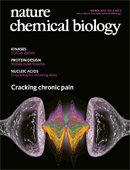导读:阿尔茨海默症是一种致命的脑变性疾病,科学家预言,到2050年全球85个人当中就会有1个人患此病。但是,也许减缓或者防止阿尔茨海默病的发展,只需要确保大脑蛋白上的糖分子不被降解。

阿尔茨海默症是一种致命的脑变性疾病,科学家预言,到2050年全球85个人当中就会有1个人患此病。但是,也许减缓或者防止阿尔茨海默病的发展,只需要确保大脑蛋白上的糖分子不被降解。
这是发表在最新一期的Nature Chemical Biology上的一项研究的结论,包括西蒙•弗雷泽大学(SFU)的化学教授、加拿大化学糖生物学研究主席David Vocadlo在内的7个人共同完成了这项研究。
该杂志已经发表了这些研究者的题为"Increasing O-GlcNAc slows neurodegeneration and stabilizes tau against aggregation"的论文。
Vocadlo和他的同事向我们阐述了他们是如何利用他们化学合成的抑制剂(Thiamet-G)来阻止O-GlcNAcase(一种自然产生的酶)分解Tau蛋白上的糖分子的。
Vocadlo说:“Tau能促进大脑中的一种被称为微管的结构形成。微管就像细胞里的‘高速公路’,能给细胞内的物质运输提供轨道。”
此前有研究表明,这些糖分子和蛋白质(如Tau)之间的连接是必不可少的。而事实上,Vocadlo说,研究人员也曾试过培育蛋白质上不附着这些糖分子的老鼠,但是他们失败了。
身为业余象棋爱好者的Vocadlo已经成功地利用他和他的学生在SFU化学系的化学糖生物学实验室合成的抑制剂“将死”了这些问题酶。
在Vocadlo之前,已经有人证明在阿尔茨海默症患者大脑中的Tau上几乎没有这些糖分子的附着,而O-GlcNAcase就是那个“强盗”酶。
开始出现这种异常的Tau是阿尔茨海默症的早期征兆,并且病情会随着它们的增多而愈发严重。
Scott Yuzwa和Xiaoyang Shan是Vocadlo实验室的研究生,他们发现,通过每日给小鼠服用一定剂量的Thiamet-G,能够阻止O-GlcNAcase分解Tau上的糖分子。他们俩是这篇论文的并列第一作者。
这个科研小组发现,被给予抑制剂的小鼠产生异常Tau的量大大减少,能拥有更加健康的大脑。
“我们的研究显示,将目光放在如何抑制O-GlcNAcase活性上,也许能成为一个全新的阿尔茨海默症治疗方向。这一点在阿尔茨海默症愈演愈烈的今天显得尤为重要。”
“为了应对这种顽劣的疾病,再多的努力都不为过,人们需要研究出尽可能多的治疗方案,这样才能最大限度地提高成功几率。短期来讲,我们需要研发出更好的O-GlcNAcase抑制剂,并在老鼠身上试验。一旦找到适合的抑制剂,我们就会将其应用于临床试验。”

Increasing O-GlcNAc slows neurodegeneration and stabilizes tau against aggregation
Scott A Yuzwa, Xiaoyang Shan, Matthew S Macauley, Thomas Clark, Yuliya Skorobogatko, Keith Vosseller & David J Vocadlo
Oligomerization of tau is a key process contributing to the progressive death of neurons in Alzheimer's disease. Tau is modified by O-linked N-acetylglucosamine (O-GlcNAc), and O-GlcNAc can influence tau phosphorylation in certain cases. We therefore speculated that increasing tau O-GlcNAc could be a strategy to hinder pathological tau-induced neurodegeneration. Here we found that treatment of hemizygous JNPL3 tau transgenic mice with an O-GlcNAcase inhibitor increased tau O-GlcNAc, hindered formation of tau aggregates and decreased neuronal cell loss. Notably, increases in tau O-GlcNAc did not alter tau phosphorylation in vivo. Using in vitro biochemical aggregation studies, we found that O-GlcNAc modification, on its own, hinders tau oligomerization. O-GlcNAc also inhibits thermally induced aggregation of an unrelated protein, TAK-1 binding protein, suggesting that a basic biochemical function of O-GlcNAc may be to prevent protein aggregation. These results also suggest O-GlcNAcase as a potential therapeutic target that could hinder progression of Alzheimer's disease.
文献链接:https://www.nature.com/nchembio/journal/vaop/ncurrent/full/nchembio.797.html








